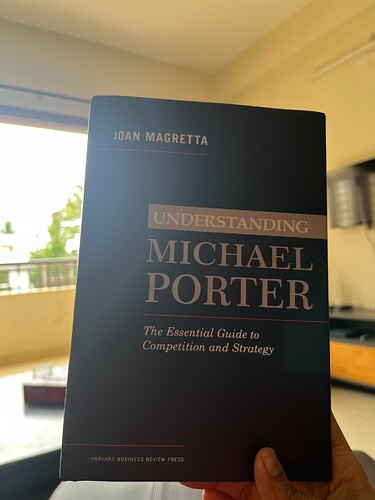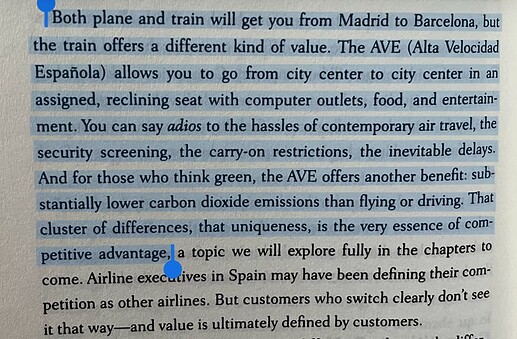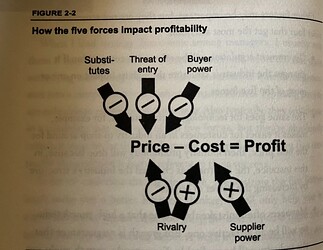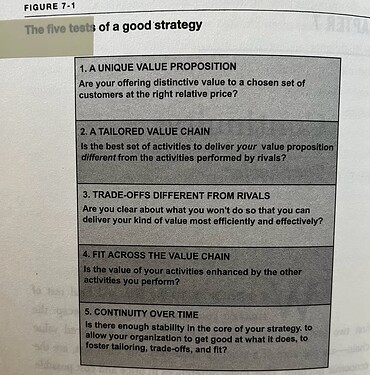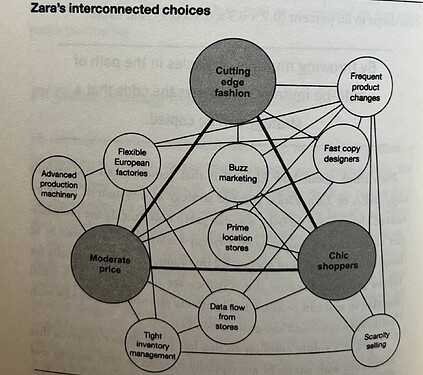Understanding Michael Porter by Joan Magretta
The book provides a comprehensive overview of Porter’s contributions to the field of business strategy and the impact his ideas have had on the way businesses approach competition and corporate strategy. It covers a range of topics related to Porter’s work, including his Five Forces model, Value Chain analysis, and his ideas about competitive advantage and corporate social responsibility.
My Notes :
It’s one of those books which you do not gobble like a fast food but chew slowly as a gourmet . The best part is it first provide’s you with a road map as to what the book would be talking about
Part 1 : What is Competition ?
Part 2 : What is Strategy ?
The Right Mind-Set
- It shows that the fight is not to be the best , it is about how to be unique and make your own place in the world , marketplace whatever you are doing .
- Competitive Advantage is when you create your own space , and be unique and competition can grow with you in place .
- Competition if taken seriously would be counterintuitive and term for this is ‘ competitive convergence’
An example to make sense of the point :
The 5 Forces
This defines the intensity of rivalry among existing competitors and determines the ind structure :
- The bargaining power of buyers (the industry’s customers)
- The bargaining power of suppliers
- The threat of substitutes
- The threat of new entrants
- Rivalry among Existing Competitors
Porter also mentioned that analysing a company using this methodology over SWOT analysis would give you a better edge as all of these pointers straight impacts your profit :
- Competitive Success idea can be captured well using ROIC ( Return on Invested Capital )
ROIC weighs the profits a company generates versus all the funds invested in it, operating expenses and capital. Long-term ROIC tells you how well a company is using its resources.’ It is also, Porter points out, the only measure that matches the multidimensional nature of competition: creating value for customers, dealing with rivals, and using resources productively. ROIC integrates all three dimensions. Only if a company earns a good return can it satisfy customers in a sustainable way.
Talking all about Strategy now :
If you have a strategy, you should be able to link it directly to your P&L.
The big idea here is this: Strategy choices aim to shift relative price or relative cost in a company’s favor. Ultimately, of course, it’s the spread between the two that matters: any strategy must result in a favorable relationship between relative price and relative cost.
A distinct strategy will produce its own unique structure. One strategy might, for example, result in 20 percent higher costs but 35 percent higher price. Companies such as Apple or BMW lean in that direction.
Another strategy might lead to 10 percent lower costs and 5 percent lower price. Companies such as IKEA and Southwest have chosen this kind of structure. Where the net result of the configuration is positive, the strategy has, by definition, created competitive advantage.
What a good strategy for a business should have , try to relate these pointers with the company you hold ![]()
A good example to drill the idea is of Zara :
Think of Zara as a system perfectly designed to optimize the deliv.ery of its distinctive value proposition. I say “optimize” because if you look at what Zara does, piece by piece, some of the choices will surprise you. Some of its choices, for example, may not seem cost effective given Zara’s low relative price positioning. Its large design team is twice the size of H&M’s, another hot European fashion retailer.
Unlike its rivals, Zara does its own manufacturing, and most of it is done in Europe, not Asia. Its stores are located in the highest-rent districts in town. None of these choices is, by itself, the “low cost” solution. But when you step back and look at the whole, as a system, you realize that Zara is willing to make a suboptimal choice in one area in order to optimize the whole.
-
Unique Proposition : First, the role of the designers is to spot trends and copy them. Rather than pay big-name designers big bucks to create something new, the company has scouts around the world looking for the latest fashion trends at shows and in nightclubs. Its large team of in-house designers can create a new collection in under a month and can modify existing collections in a couple of weeks. The size of the team allows Zara to be a fast copier, getting those new designs into production quickly.
-
Tailored Value Chain : Zara began not as a retailer but as a manufacturer, and true to its roots it continues to do a sizeable amount of production in-house, in Europe, and in plants configured for small-batch production. Zara owns a fleet of trucks to speed goods from its centralized logistics hubs in Spain to its stores throughout Europe in twenty four hours or less. And, again counter to industry practice, garments arrive ticketed and hung. This raises shipping costs but means the merchandise arives ready to sell, needing no in-store ironing. Speed is the theme.
-
Trade-off’s different from Rivals : Zara sells the latest-fashion clothes at moderate prices (not low in absolute terms, but low relative to fashion brands). Its key insight into how to deliver that particular value proposition is speed.
The stores themselves -in prominent locations with high foot taffic- are spacious. But the new goods that come twice a week
4. Fit across the value chain :
- Continuity over time : Everything Zara does is tailored to getting the latest styles into its stores fast. Most fashion retailers can live with lead times of three months. Zara’s are just two to four weeks, allowing it to release one hundred collections per year. This blistering pace is possible because Zara controls its value chain from end to end, and its choices all along the value chain are different from its rivals. Zara makes some significant trade-offs–in how it promotes its brand, how it designs its merchan-dise, and how it manages production, logistics, and inventory Zara’s success comes not from one choice, but from the way these many choices fit together to reinforce each other.
Ten Practical Implications
-
Vying to be the best is an intuitive but self-destructive approach to competition.
-
There is no honor in size or growth if those are profitless.Competition is about profits, not market share.
-
Competitive advantage is not about beating rivals; it’s about creating unique value for customers. If you have a competitive advantage, it will show up on your P&L.
-
A distinctive value proposition is essential for strategy. But strategy is more than marketing. If your value proposition doesn’t require a specifically tailored value chain to deliver it, it will have no strategic relevance.
-
Don’t feel you have to “delight” every possible customer out there. The sign of a good strategy is that it deliberately makes some customers unhappy.
-
No strategy is meaningful unless it makes clear what the organization will not do. Making trade-offs is the linchpin that makes competitive advantage possible and sustainable.
-
Don’t overestimate or underestimate the importance of good execution. It’s unlikely to be a source of a sustainable advantage, but without it even the most brilliant strategy will fail to produce superior performance.
-
Good strategies depend on many choices, not one, and on the connections among them. A core competence alone will rarely produce a sustainable competitive advantage.
-
Flexibility in the face of uncertainty may sound like a good idea, but it means that your organization will never stand for anything or become good at anything. Too much change can be just as disastrous for strategy as too little.
-
Committing to a strategy does not require heroic predictions about the future. Making that commitment actually improves your ability to innovate and to adapt to turbulence.
This is one of those books which I feel needs to be revisited time to time , because as your situation changes in life it can give you a different perspective . Just rating it on my personal opinion as a 8/10 ! Thanks for the read , Hope this added some value for you today ![]()
| Subscribe To Our Free Newsletter |

